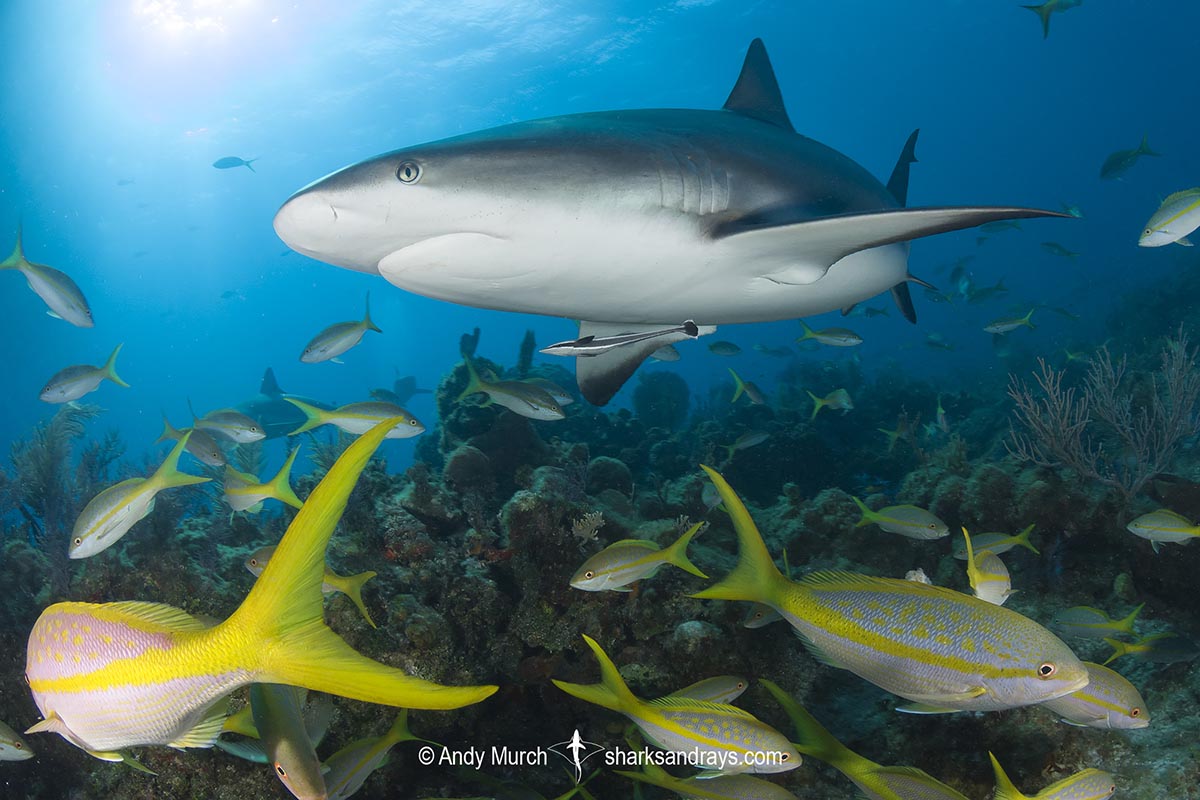Common name(s)
Caribbean Reef Shark, Reef Shark.
Binomial
Carcharhinus perezii
Synonyms
Carcharhinus perezi, Carcharhinus springeri, Eulamia springeri, Platypodon perezii
Identification
Relatively stout body. Snout short and rounded. Origin of first dorsal fin level with free rear tip of pectoral fin. Free rear tip of second dorsal quite short. Interdorsal ridge present. Dorsal coloration greyish-brown with subtle flank stripe. White ventrally.
Size
Maximum length 249cm (Jose Castro). Often listed as reaching 295cm based on a single specimen measured by Garrick in 1982 but the species’ identity is questionable. Size at birth 70-73cm.

Conservation Status
ENDANGERED
Despite the Caribbean Reef Shark’s widespread distribution in the Caribbean Sea from the southeastern US to Brazil, this species has a low productivety (3-6 pups every two years) and continues to decline; up to 99% in areas where it is not protected. However, where shark sanctuaries exist (such as in the Bahamas) CRS populations have remained stable since the 1980s.

Habitat
Caribbean reef sharks inhabit the outer slopes of coral reefs and drop-offs. They also enter shallow bays and lagoons, and are known to visit mud flats in river deltas in Brazil. Generally found from the surface to 30m but in the San Andrés Archipelago, Colombia it is reported from depths of 45 to 225m (Caldas 2002), and through satellite telemetry is now known to dive to 378 m
Distribution
The Caribbean reef shark has a small and fragmented range in the western tropical Atlantic. It is found from southern Florida to Brazil, including the Gulf of Mexico and most Caribbean Islands. South of Venezuela, and through the Guyanas records are limited. In Brazil, it is found from the northern border to Rio, and then from Florianopolis to northern Uruguay.
Reproduction
A viviparous species with yolk-sac placenta. 3-6 pups per litter. Gestation is approximately 12 months.
Diet
Diet consists mostly of bony fishes. Surprisingly little is known of the Caribbean reef shark’s biology considering that it is the most common shark on reefs in the Caribbean.
Behavior
Remains close to reefs and drop-offs in a relatively small home range. The Caribbean reef shark is known to enter caves and rest on the substrate, although it does not have the physiology necessary for buccal ventilation; the muscle control needed to pump water over the gills to breath that sedentary shark species possess. Researchers hypothesize that the particular caves where this takes place may contain currents that are especially oxygen rich.
Reaction to divers
Shy in remote areas where it is rarely disturbed, but otherwise fairly nonchalant around divers. Caribbean reef sharks have been responsible for numerous bites during baited dives. Hence, many shark feeders in the Bahamas wear chainmail suits.
Diving logistics
Caribbean reef sharks can be encountered at many sites throughout the Bahamas and the Caribbean.
Arguably the most famous shark dive in the western Atlantic (if not the world), Stuart Cove based on New Providence Island, offers daily baited dives with scores of CRSs. This is a very well establish feed, reliable, and great for new divers looking for a taste of shark diving without signing up for a dedicated trip.
Stuart Cove’s also offers a ‘Shark Feeder Course’ where divers can don a chainmail suit and learn how to feed and handle sharks. IMO, this is more of a ‘box tick’ for cert. collectors, rather than a viable way to learn enough about sharks to bait and handle them in other areas, but it is an opportunity to learn some basics.
On Grand Bahama Island, Unexso offers a similar baited shark dive with Caribbean reef sharks.
At Tiger Beach the is a site called Fish Tales with an omnipresent squadron of Caribbean reef sharks, as well as lemons, tigers, nurse sharks, and sometimes bull sharks and great hammerheads. Other than the variety of species, the nice thing about Tiger Beach is the reef backdrops and the freedom that divers have to do their own thing rather than sit in a line and wait for the sharks to swim past. When we (Big Fish Expeditions) lead trips to the area, we split the dives between tiger shark feeds next to the reef, and freestyle dives on the reefs; sometimes with a hidden bait crate to encourage the sharks to swim over a particularly colourful area of reefscape to help photographers get the best images.
Neal Watson’s Scuba Adventures based on North Bimini Island offers baited Caribbean reef shark dives at a spot called Triangle Rocks. The site only has around a dozen CRS’s but they are bold enough for good images and you can see small blacknose sharks there.
Further south in Caribbean, there are a number of island nations that offer shark feeds with CRS’s. Dive Safaris on Sint Maarten has a well established feed.
Waihuka Adventure Divers on Roatan Island (in the Bay Islands of Honduras) has a good feed that also has a reef backdrop. It takes place in approx. 25m depth and often has great visibility due to Roatan’s sheer walls and lack of run-off.
In Cuba, divers can enjoy baited dives with Caribbean reef sharks at Jardin de la Reina; a beautiful spot with pristine corals and abundant sharks.
Similar species
Blacktip Shark Distinguished by pointed snout, black fin tips, and prominent white flank stripe.
Bull Shark Distinguished by heavier body, very short snout, and proportionately lower and broader first dorsal fin.
Galapagos Shark Very similar in appearance to the CRS but extremely rare in the western Atlantic. First dorsal fin more erect. Longer free rear tip on second dorsal fin.




















